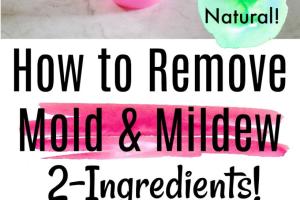Ultimate Guide to Removing Mold and Mildew: Effective Methods and Prevention Tips

-
Quick Links:
- Understanding Mold and Mildew
- Health Risks Associated with Mold and Mildew
- Identifying Mold and Mildew in Your Home
- Methods for Removing Mold and Mildew
- Preventing Future Mold and Mildew Growth
- Case Studies: Successful Mold Remediation
- Expert Insights on Mold Management
- FAQs
Understanding Mold and Mildew
Mold and mildew are types of fungi that thrive in damp environments. While they may seem similar, they have different characteristics and require different approaches for removal. Mold typically appears as dark spots or patches and can penetrate surfaces, while mildew is often powdery and appears lighter in color. Understanding these differences is crucial for effective treatment.
What Causes Mold and Mildew?
Both mold and mildew require moisture to grow. Common sources of moisture include:
- Leaky roofs or plumbing
- High humidity levels
- Condensation on windows and walls
- Flooding or water damage
Health Risks Associated with Mold and Mildew
The presence of mold and mildew can pose serious health risks, particularly for individuals with respiratory issues, allergies, or weakened immune systems. Symptoms may include:
- Coughing and sneezing
- Skin irritation
- Headaches and fatigue
- Respiratory problems
Long-term exposure can lead to more severe health complications, making it essential to address any mold problems promptly.
Identifying Mold and Mildew in Your Home
Before you can remove mold and mildew, you need to identify where they are located. Common areas to inspect include:
- Basements and crawl spaces
- Bathrooms and kitchens
- Behind wallpaper and under carpets
- Around windows and doors
Signs of mold and mildew include:
- Visible growth on walls, ceilings, or floors
- A musty odor
- Water stains or discoloration
Methods for Removing Mold and Mildew
Once you've identified the affected areas, it’s time to tackle the removal process. Here are effective methods:
1. DIY Cleaning Solutions
Many household items can effectively remove mold and mildew:
- Vinegar: Spray undiluted white vinegar on the affected area and let it sit for an hour before wiping it away.
- Baking Soda: Mix baking soda with water to create a paste. Apply it to the moldy area and scrub gently.
- Hydrogen Peroxide: Use a 3% hydrogen peroxide solution, spray it on the mold, and let it sit for 10 minutes before scrubbing.
2. Commercial Cleaning Products
For tougher mold infestations, consider using commercial mold removers. Ensure they are safe for the surfaces you are treating.
3. Professional Mold Remediation
If the mold problem is extensive, hiring a professional mold remediation service may be the best option. They have the tools and expertise to safely remove mold and prevent it from returning.
Preventing Future Mold and Mildew Growth
Once you've successfully removed mold and mildew, it's vital to take steps to prevent it from returning:
- Keep humidity levels below 50% using dehumidifiers.
- Ensure proper ventilation in bathrooms and kitchens.
- Fix leaks promptly and address any water damage.
- Regularly clean and maintain gutters to prevent water accumulation.
Case Studies: Successful Mold Remediation
Understanding how others have successfully dealt with mold can provide valuable insights. Here are a few case studies:
Case Study 1: The Basement Mold Problem
A family discovered mold in their basement after a heavy rain. They used a combination of vinegar and baking soda for removal and installed a dehumidifier, which effectively reduced humidity levels, preventing future growth.
Case Study 2: Bathroom Mold
In a small apartment, tenants found mold around the bathroom tiles. They applied hydrogen peroxide and regularly checked for leaks, successfully eliminating the mold and keeping the area dry.
Expert Insights on Mold Management
Experts recommend regular inspections and maintenance to keep mold at bay. Here are some tips:
- Conduct seasonal checks in high-risk areas.
- Stay informed about mold prevention techniques.
- Educate family members about the importance of cleanliness and moisture control.
FAQs
1. What is the difference between mold and mildew?
Mold is typically darker and can penetrate surfaces, while mildew is lighter and usually found on surfaces.
2. Can I remove mold myself?
Yes, small areas of mold can often be removed using DIY methods; however, for extensive infestations, professional help is recommended.
3. What are the health risks associated with mold exposure?
Exposure to mold can lead to respiratory issues, allergies, and other health complications.
4. How can I prevent mold growth in my home?
Keep humidity levels low, ensure proper ventilation, and address leaks immediately.
5. Is bleach effective against mold?
While bleach can kill mold on non-porous surfaces, it does not prevent mold from returning. Other methods may be more effective.
6. How can I tell if the mold is dangerous?
Black mold is often considered more dangerous, but any mold can pose health risks, particularly for sensitive individuals.
7. How long does it take to remove mold?
The time needed for mold removal depends on the extent of the infestation and the methods used.
8. Can mold return after removal?
Yes, if moisture issues are not addressed, mold can return after removal.
9. What are the best products for mold removal?
Look for products that are specifically designed for mold removal and are safe for the surfaces being treated.
10. How often should I check for mold?
Regular inspections every season or after heavy rains can help catch mold early.
Random Reads
- How to put up shelves
- How to put iphone ipod touch recovery mode
- How to open xbox one console
- How to open view dwg files
- Retrieve old whatsapp messages
- Retrieve mobile number sim
- How to rip a dvd
- How to reuse paint roller
- How to replace a fence post in concrete
- The ultimate guide to safely cutting cement backer board